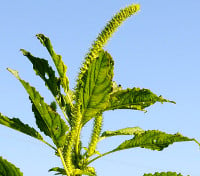 You're sneezing, congested and watery eyed, battling nature's small wonders. So today we're going to shine a spotlight on these little airborne particulates that are giving you such a hard time, and this week we'll start with pollen.
You're sneezing, congested and watery eyed, battling nature's small wonders. So today we're going to shine a spotlight on these little airborne particulates that are giving you such a hard time, and this week we'll start with pollen.
Since the biodiversity of plants is immense, so is the variety of pollen types. For those dealing with allergies, the most troublesome pollen comes from trees and wind pollinating plants such as grasses and those of the Aster (daisy) family.
Tree Pollen
Trees can produce massive amounts of pollen and start pollen production as early as January through as late as June. This makes Spring and Fall the most irritating seasons for allergies. Size of pollen grains vary in size, but are light enough to allow the wind to carry them for miles. Amongst the trees mentioned below, their pollen sizes range from 18-38 micrometers (microns). Pecans have the largest pollen of 77 microns! Stuffy nose, watery eyed, and congested individuals can thank the following trees for their irritating pollens:
- Elm
- Walnut
- Pecan
- Hickory
- Sycamore
_
_
_
_
It's also interesting to note that pollen is released from the male structure of the plant (the anther). Some tree species have seperate sexes, instead of having both male and female reproductive parts. So the female versions of lets say, maples, do not release pollen. Here is a list of male trees that contribute to allergy season:
- Ash
- Box elder
- Cottonwood
- Maple (silver and red)
- Poplar
- Willow
_
_
_
_
_
_ Ragweed Pollen
Ragweed Pollen
Ragweeds are from the Aster family, and often inhabit dry sunny fields, or interrupted areas such as roadsides or vacant lots. There are 17 species nationally with a few dozen found worldwide. Ragweed pollen season runs in the autumn, with September traditionally being the peak month for high levels of ragweed pollen. Aside from being very light and easily carried by the wind, another thing that makes ragweed so potent is that though it has a short season, it makes the most of its time. Single plants can produce over a billion grains of pollen in a single season. Ragweed pollen grains range from 16-27 microns. Though ragweed is what most people are familiar with, here are some other weeds to beware of:
- Curly Dock
- Lambs Quarters
- Pigweed
- Plantain
- Sheep Sorrel
- Sagebrush
_
_
_
_
_
_Grass Pollen
There are approximately 1,200 species of grass in North America, but of that number, there are only a few that cause allergic reactions. Grass is extremely wind dependent for seed and pollen dispersal though the pollen sizes can be as large as 35 microns. So, with their large pollen size they are less likley to irrittate lower airways, thus not quite as irritating as ragweed or tree pollen. Some of the most common grass pollens are:
- Bermuda
- Kentucky
- Johnson
- Orchard
- Sweet Vernal
- Timothy
_
_
_
_
_
_Although pollen is everywhere (even at the North Pole!), there are ways to deal with it. Between 5-10 am., it's a veritable pollen party. So stay indoors until after 10, and you'll be less congested and red eyed. Drying clothes outside exposes clothes to pollen, which can then be transported inside. Depending on your specific allergies, you may want to limit how often you do this, depending on the time of year. Wearing a mask while cutting the grass, doing yard work, or working in the hayfield will help make these chores less miserable. Keeping the grass shorter, instead of allowing to grow tall and come to seed, can also help alleviate allergies.
_Author: R. Power
